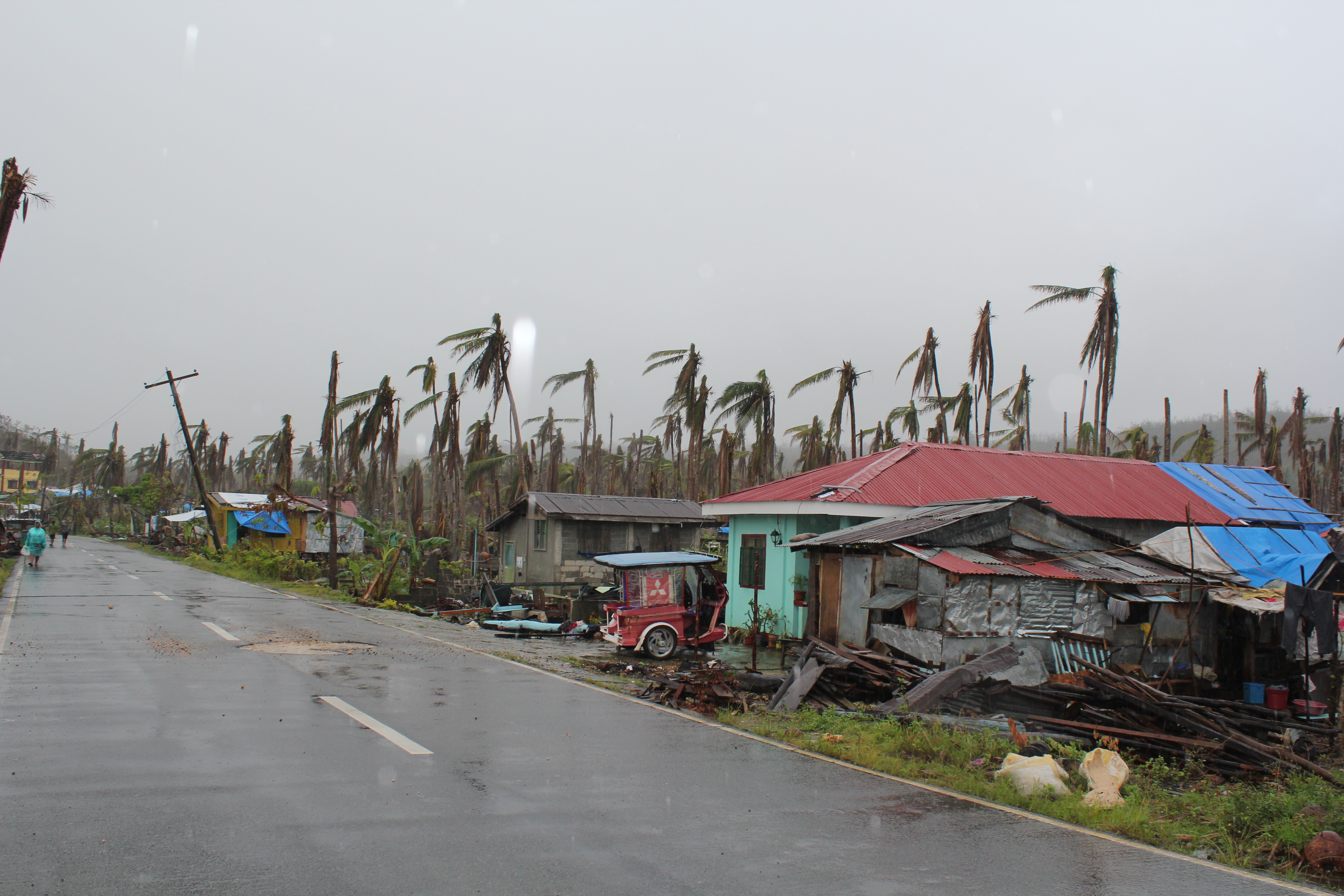
MCA-Philippines
A road section of Guiuan, Eastern Samar, where typhoon Haiyan had its first landfall in November 2013 and made history as the strongest typhoon ever to hit land.
“Rise, Philippines” is a special three-part blog series that takes a look back at the crushing blow dealt by Typhoon Haiyan in November 2013, the resiliency of Filipinos and MCC’s continuing work in promoting poverty reduction in the Philippines through economic growth. Read about the status of our compact.
Days before Typhoon Haiyan made its first landfall in the Philippines, my colleagues and I at MCA-Philippines were as terrified and scared as every Filipino at the thought of being on the receiving end of the strongest typhoon in history to hit land. What we did not imagine was how Haiyan would wreak havoc in areas along its path.
On that fateful Friday, Nov. 8, 2013, work in Manila was suspended. At home, I was glued to the television from early morning until night, watching newscasts on the supertyphoon ravaging Eastern Visayas . The sound of howling winds and the sight of rising floods in familiar areas in Leyte—where MCA-Philippines is implementing a range of small-scale, community-driven infrastructure projects—sent chills down my spine. My thoughts were with the colleagues, friends and acquaintances in Tacloban and nearby towns.
On the morning of Nov. 9, I woke up to the horrific television views of the devastation that befell Tacloban. It was inconceivable, unimaginable. We have seen and experienced many typhoons in the past, especially within the past three years with more and stronger typhoons. None, however, equaled the magnitude of the destruction that Haiyan brought to our country.
When we returned to the office on Nov. 11, we immediately mobilized a team to assess the situation in our project areas and the impact on our road project. The plan was put on hold, however, as Eastern Visayas remained isolated and inaccessible. Food was becoming scarce. Communication lines were cut off, and the airport was totally unusable for commercial flights.
We learned that our road contractors quickly responded to calls of assistance by deploying their trucks and heavy equipment to Tacloban and the towns of Eastern Samar for road-clearing operations. Contractors also lent their trucks to local governments or provided fuel to other vehicles to pick up and deliver relief goods to the region’s devastated areas.
On Nov. 13, MCA-Philippines issued a statement of solidarity and support for the typhoon victims. Our call was simple: Bangon, Pilipinas! or “Rise, Philippines!”
We launched our own campaign to solicit donations from MCA-Philippines employees and the public. We set up donation boxes in our office lobby for clothes, bedding, towels, and toys. We decided to forgo our annual Christmas party, opting for a simple dinner instead. The money that was supposed to have been spent for the party was donated to our two drivers at the project site as well as to road contractors and employees of our partner agencies, the Department of Public Works and Highways and the Department of Social Welfare and Development. The in-kind donations were sent to the Department of Social Welfare and Development’s regional office for the typhoon victims in Tacloban.
On Dec. 8, exactly a month after Haiyan hit the Philippines, I flew to our road project site in Eastern Samar to get stories for a feature in a local magazine. My heart bled from what I saw. The images were more horrific than what appeared on TV. What I saw looked like scenes from war movies. Dreadful. Heartbreaking. After my return to Manila, I had to be debriefed—a form of therapy to help me cope with the trauma I witnessed personally during my trip to Leyte and Eastern Samar.
The Filipino people will be forever grateful for the international community’s assistance . The quick response by the United States to ferry survivors out of Tacloban, the pouring in of relief goods to evacuation centers, the arrival of medical teams from all over the world, and the deluge of financial pledges from international organizations and individuals gave a flicker of hope to the hungry, the homeless and even the dying among those who survived the onslaught of Typhoon Haiyan.
Many are still hungry, with their source of livelihood swept away by the floods. Many are still homeless, with only tents protecting them from the elements of nature. But Filipinos are more than resilient. We are survivors who can weather even the strongest supertyphoon. When I visited Eastern Visayas, I saw a few houses being rebuilt. Trees are beginning to turn green again. People’s confidence is still shaken, but they are slowly recovering from their catastrophic experience.
In the province of Aklan in Central Visayas, which I visited on Feb. 25, 2014, a health station in Barangay Ochando in the municipality of New Washington still stands strong despite the destruction Haiyan hailed on other nearby structures. The MCC-funded health station was completed less than a year earlier. When Haiyan was ravaging New Washington, at least 12 families used the health station as an evacuation station, with a few of them in need of temporary shelter staying there for weeks afterward..
In nearby Barangay Pinamuk-an, the chair of the Barangay Sub-Project Monitoring Committee that supervised the construction of the day care center recalled that her family was one of 15 families that sought refuge in the facility. Many other health stations, day care centers and school buildings proved their strength—and the high quality put into them by the community—at the height of the supertyphoon.
For us at MCA-Philippines, the need to finish the compact projects has become even more significant to help rebuild the areas devastated by Haiyan. We have shown that, through the compact projects, we can make a difference in the lives of our fellow Filipinos for their reconstruction and rehabilitation and, eventual recovery toward economic growth.

